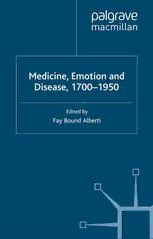
Medicine, Emotion and Disease, 1700–1950 PDF
Preview Medicine, Emotion and Disease, 1700–1950
Medicine, Emotion and Disease, 1700–1950 This page intentionally left blank Medicine, Emotion and Disease, 1700–1950 Edited by Fay Bound Alberti © Editorial matter and selection © Fay Bound Alberti 2006; Foreword © Janet Browne 2006; all remaining chapters © their respective authors 2006 Softcover reprint of the hardcover 1st edition 2006 978-1-4039-8537-8 All rights reserved. No reproduction, copy or transmission of this publication may be made without written permission. No paragraph of this publication may be reproduced, copied or transmitted save with written permission or in accordance with the provisions of the Copyright, Designs and Patents Act 1988, or under the terms of any licence permitting limited copying issued by the Copyright Licensing Agency, 90 Tottenham Court Road, London W1T 4LP. Any person who does any unauthorised act in relation to this publication may be liable to criminal prosecution and civil claims for damages. The authors have asserted their rights to be identified as the authors of this work in accordance with the Copyright, Designs and Patents Act 1988. First published 2006 by PALGRAVE MACMILLAN Houndmills, Basingstoke, Hampshire RG21 6XS and 175 Fifth Avenue, New York, N.Y. 10010 Companies and representatives throughout the world PALGRAVE MACMILLAN is the global academic imprint of the Palgrave Macmillan division of St. Martin’s Press, LLC and of Palgrave Macmillan Ltd. Macmillan®is a registered trademark in the United States, United Kingdom and other countries. Palgrave is a registered trademark in the European Union and other countries. ISBN 978-1-349-54036-5 ISBN 978-0-230-28603-0 (eBook) DOI 10.1057/9780230286030 This book is printed on paper suitable for recycling and made from fully managed and sustained forest sources. A catalogue record for this book is available from the British Library. Library of Congress Cataloging-in-Publication Data Medicine, emotion and disease, 1700–1950/(ed.) Fay Bound Alberti. p. cm. Includes bibliographical references and index. Contents: Introduction. Emotion theory and medical history/Fay Bound Alberti— Emotions in the early modern medical tradition/Fay Bound Alberti—Patients and passions/Thomas Dixon—Languages and land- scapes of emotion/Hilary Marland—‘‘Cold calculation in the faces of horrors?”/Bertrand Taithe—Sympathy under the knife/Paul White— Fear and loathing in the laboratory and clinic/Otniel Dror—From Clever Hans to Michael Balint/Rhodri Hayward—Diagnosing with feel- ing/Susan Lanzoni. 1. Emotions–Health aspects. 2. Medicine, Psychosomatic. 3. Mind and body. I. Alberti, Fay Bound, 1971- R726.5.M437 2006 616.001'9—dc22 2006041814 10 9 8 7 6 5 4 3 2 1 15 14 13 12 11 10 09 08 07 06 For Millie, Jacob and Sam This page intentionally left blank Contents Foreword by Janet Browne ix Acknowledgements x Notes on Contributors xi Introduction: Emotion Theory and Medical History xiii Fay Bound Alberti Chapter 1: Emotions in the Early Modern Medical Tradition 1 Fay Bound Alberti Chapter 2: Patients and Passions: Languages of Medicine and Emotion, 1789–1850 22 Thomas Dixon Chapter 3: Languages and Landscapes of Emotion: Motherhood and Puerperal Insanity in the Nineteenth Century 53 Hilary Marland Chapter 4: ‘Cold Calculation in the Faces of Horrors?’ Pity, Compassion and the Making of Humanitarian Protocols 79 Bertrand Taithe Chapter 5: Sympathy under the Knife: Experimentation and Emotion in Late Victorian Medicine 100 Paul White Chapter 6: Fear and Loathing in the Laboratory and Clinic 125 Otniel E. Dror Chapter 7: From Clever Hans to Michael Balint: Emotion, Influence and the Unconscious in British Medical Practice 144 Rhodri Hayward vii viii Contents Chapter 8: Diagnosing with Feeling: The Clinical Assessment of Schizophrenia in Early Twentieth-Century European Psychiatry 169 Susan Lanzoni Index 191 Foreword This volume brings together the work of eight historians specializing in the medical aspects of emotions. It began as a workshop held at the Wellcome Trust Centre for the History of Medicine at University College London in October 2004 and has grown pleasantly from there. Our objective was to explore key developments in the history of medicine and emotion in Europe and North America from the eighteenth century to the present day and to turn a fresh eye on the issues that historians face when analyzing emotions as lived experiences as well as medical categories. For 'emotions' have not only become a topic on the modern medical curriculum involving medical practitioners and patient groups in a mutual search for greater empathy and understanding, but also concern scholars investigating the history of the body, narratives of healing, the gradual politicization of the languages of feeling, the con- struction of gendered disease categories and the impact of our current emphasis on scientific detachment and objective diagnosis in the real world of emotional experience. However, it is clear that it is not enough merely to emote or empathize. Emotions are culturally embedded phe- nomena that cannot easily be captured in text and, to historians and medical professionals alike, mostly exist only as representations. All we have are representations of feelings. Much interesting work is conse- quently turning towards the places and 'performances' sites of these rep- resentations. The papers published here engage with the management of emotion in the patient/physician relationship from the eighteenth century, the function of gendered emotions in typically female disor- ders like puerperal insanity, the 'objectifications' of emotions as they began to be measured in the lab, the development of sympathy and anxiety as particularly useful categories for late-nineteenth century medical professional, and the shift from compassion to humanitarianism as a sharp political move in the present day. They are astute, innovative and lively. We are extremely grateful to the participants for their contri- butions and believe that their papers open important new doors to the relationships between medicine, medical practice and emotions. Professor Janet Browne Wellcome Trust Centre for the History of Medicine at UCL. ix
